Illinois was both warmer and wetter than the 1991–2020 normal in 2021. The statewide average annual temperature was 53.7 degrees, 1.1 degrees above normal and tied for the 10th warmest year on record. Statewide total precipitation in 2021 was 41.06 inches, 0.31 inches above normal and the 37th wettest year on record.
2021 Temperatures
The mild start to the 2020-2021 winter spilled over into the first month of the year. January average temperatures were nearly 3 degrees above the 1991–2020 normal. This was followed by an extremely cold February that was 10 degrees below the 1991–2020 normal and the 11th coldest on record statewide. March was nearly 5 degrees warmer than normal, followed by April and May, which were both slightly cooler than normal. Although July was slightly cooler than normal, it was outweighed by June and August that were both nearly 2 degrees warmer than normal. September and October were 2.7 and 5.4 degrees above normal, respectively. October was the sixth warmest on record statewide and the warmest since 1971. The year ended with a slightly cooler than normal month of November and an extremely warm December that was 8 degrees above normal. The final month of 2021 was the second warmest December on record statewide.
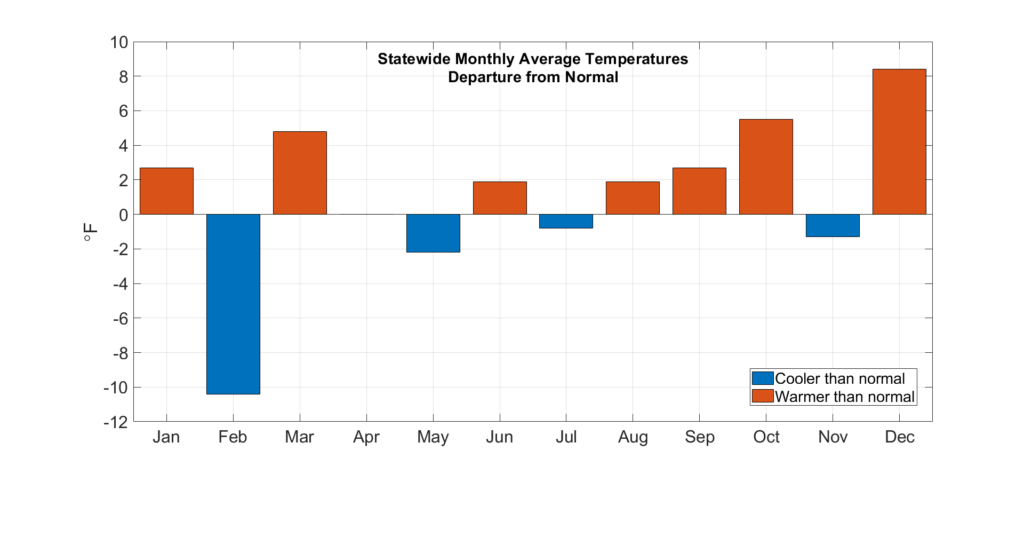
The maps below show 2021 average temperatures and departures from normal across the state. Average temperatures ranged from the high 40s in far northern Illinois to the high 50s in the southern half of the state. Most of the state was 1 to 2 degrees warmer than the 30-year normal, whereas the southern two-thirds of the state was within 1 degree of normal, and northeast Illinois was 2 to 3 degrees warmer than normal.
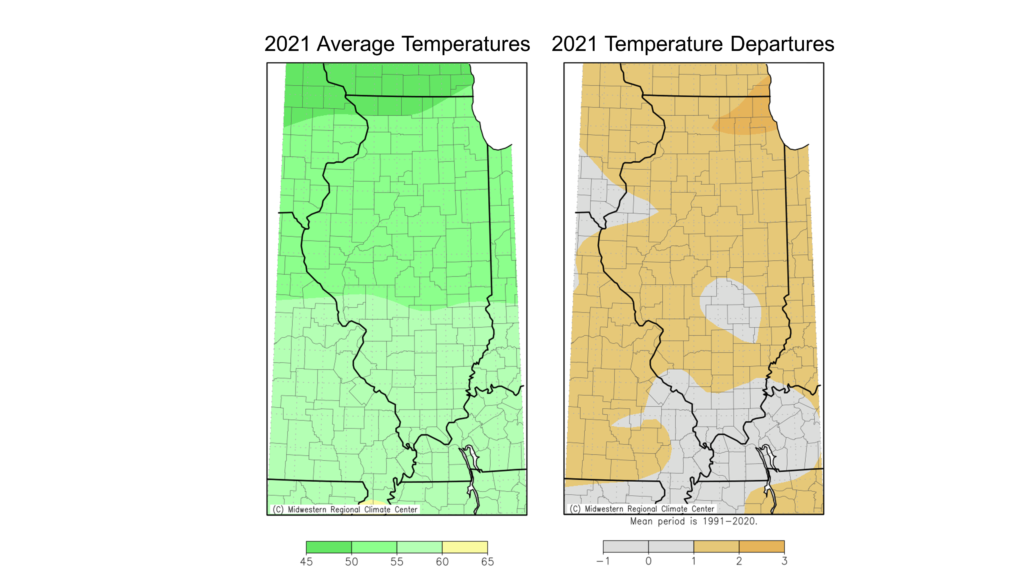
Figure 2. Maps show 2021 annual average temperature (left) and average temperature departures from the 1991–2020 normal (right).
The year 2021 tied with 1998 as the 4th warmest year on record in Chicago and was the 4th warmest year in Rockford, the 7th warmest year in Moline, the 6th warmest in St. Louis, and the 13th warmest in Peoria. Statewide, 10 of the top 20 warmest years on record have occurred since 1990.
The table below shows the number of daily weather records broken at Illinois Cooperative Observer stations in each month of 2021.
December led with the most number of high daily maximum temperature records with 116, and October led with the most high daily minimum temperature records with 60. Fifteen stations in Illinois also broke the all-time December high maximum temperature records in 2021, including a 72-degree high in Galesburg on December 16.
Last year’s intense February broke 243 daily low maximum temperature records and 92 daily low minimum temperature records, the highest of all months. Over the entire year, more than twice as many low maximum temperature records were broken as low minimum temperature records. Illinois’ climate has warmed over the past 100 years, but daily minimum temperatures have increased at a larger rate than daily maximum temperatures. This disproportionate change resulted in fewer daily low minimum temperature records broken.
| Daily | High Maximum Temperature | High Minimum Temperature | Low Maximum Temperature | Low Minimum Temperature | High Precipitation |
| January | 0 | 1 | 0 | 0 | 59 |
| February | 0 | 0 | 243 | 92 | 46 |
| March | 20 | 18 | 0 | 0 | 76 |
| April | 13 | 41 | 34 | 21 | 41 |
| May | 6 | 24 | 54 | 44 | 40 |
| June | 32 | 21 | 1 | 12 | 51 |
| July | 1 | 1 | 51 | 3 | 78 |
| August | 7 | 36 | 17 | 4 | 54 |
| September | 25 | 6 | 0 | 0 | 19 |
| October | 14 | 60 | 0 | 0 | 157 |
| November | 0 | 0 | 0 | 2 | 1 |
| December | 116 | 59 | 0 | 0 | 44 |
| Total | 234 | 267 | 400 | 178 | 666 |
There were also 666 daily total precipitation records broken across Illinois in 2021. This included 157 daily precipitation records from a very wet October. In fact, nine stations broke the all-time October daily precipitation records, including 4.32 inches on October 24 in Rantoul in Champaign County.
2021 Precipitation
Calendar year 2021 began with a slightly wetter than normal January and slightly drier than normal February. March was more than 1 inch wetter than normal statewide, but the onset of drought in northern Illinois in spring resulted in drier than normal months in April and May. All three months of climatological summer were wetter than normal, July was nearly 1 inch wetter than normal. Fall was a roller coaster, as September was about 1 inch drier than normal, followed by the fifth wettest October on record statewide and the ninth driest November on record statewide.
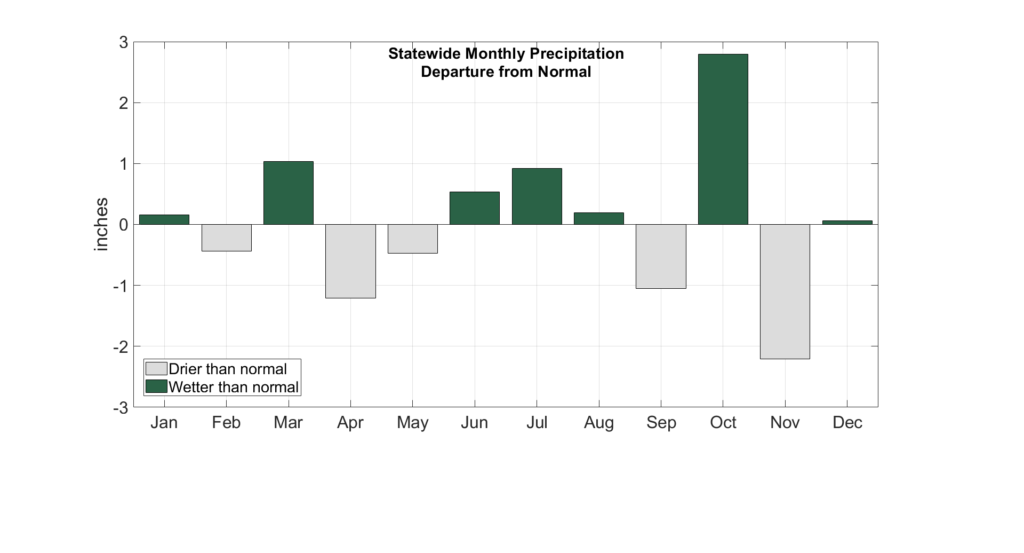
In 2021, perhaps more than most years, the statewide precipitation numbers do not properly reflect the variability of precipitation between different parts of the state. Figure 4 shows the 2021 monthly precipitation departure from normal in Rockford, Springfield, and Carbondale. While only three months of 2021 were wetter than normal in Rockford and four months were wetter than normal in Carbondale, eight months in Springfield were wetter than normal. In fact, Springfield observed five months in 2021 with more than 5 inches of precipitation, only the third time in its 120+ year record (other years were 1898 and 1977).
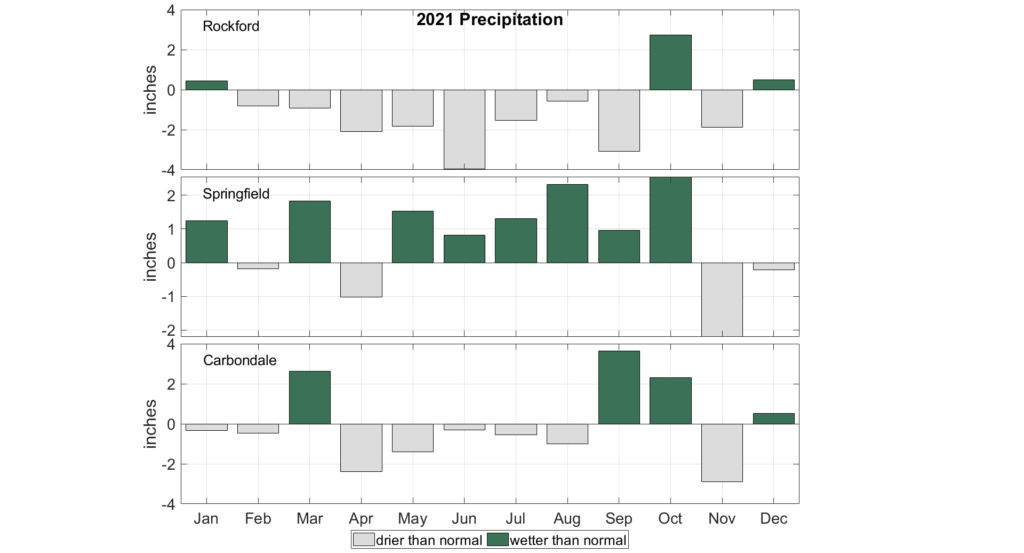
Figure 4. 2021 monthly total precipitation departure from the 1991–2020 normal in (top) Rockford, (middle) Springfield, and (bottom) Carbondale.
The maps below show the spatial variability of 2021 precipitation in more detail. Total annual precipitation ranged from less than 30 inches in northern Illinois to nearly 50 inches in southern Illinois. While most of northern Illinois was 4 to 8 inches drier than normal, most of central Illinois was 4 to 12 inches wetter than normal.
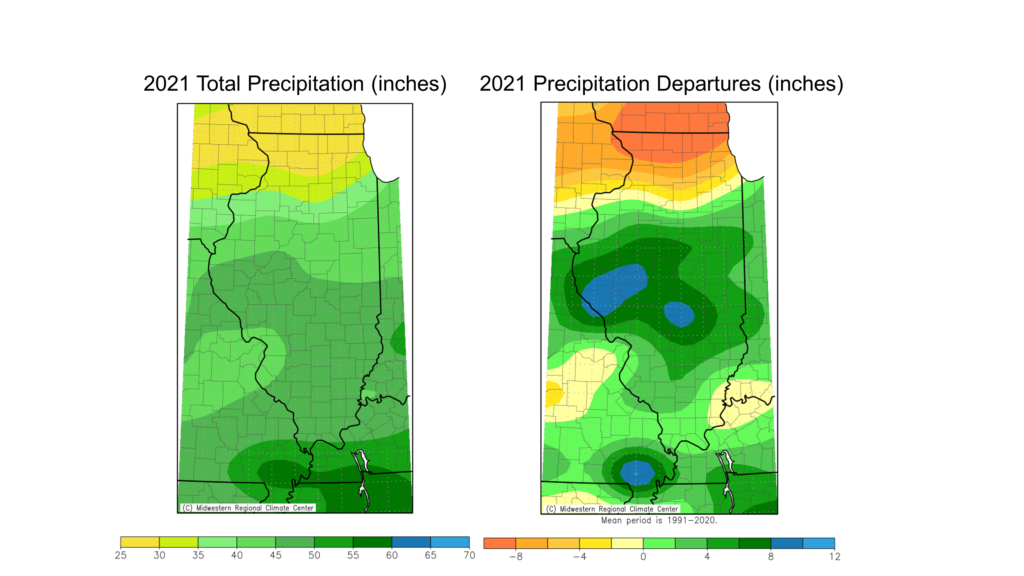
Figure 5. Maps show 2021 (left) total precipitation and (right) precipitation departure from normal.
One CoCoRaHS observer in Shelby County recorded 61 inches of precipitation in 2021, while several CoCoRaHS observers in Stephenson, Winnebago, Boone, McHenry, and Lake Counties observed less than 26 inches in 2021. The year 2021 was the 5th driest year on record in Rockford with just 24.2 inches (65 percent of normal) and the 10th driest year on record in Freeport.
Meanwhile, 2021 was also the 14th wettest year on record in Peoria, the 13th wettest year in Springfield, the 6th wettest year in Bloomington, the 8th wettest year in Danville, and the 15th wettest year in Jacksonville.
2021 Severe Weather
Last year brought more than its fair share of severe weather across Illinois. Most of our 102 counties were affected by strong wind, hail, or tornado events last year (Figure 6). Overall, the NOAA Storm Prediction Center showed 80 tornado reports, 64 hail reports, and 453 wind reports statewide in 2021.
The 80 tornado reports compare to 74 in 2020 and just 51 in 2019 and a long-term average of about 60 tornadoes per year statewide. Unfortunately, the December 10 tornado outbreak included Illinois’ first tornado-related fatalities since 2017. More information on that severe weather event is available here: https://stateclimatologist.web.illinois.edu/2021/12/16/the-december-2021-tornado-outbreak-in-illinois/.
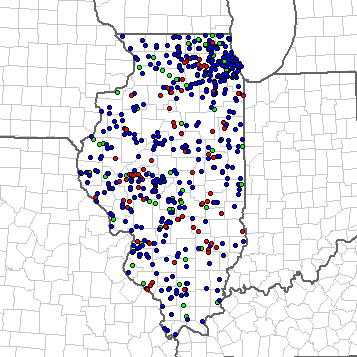
Other noteworthy severe weather events included the June 20 EF-3 tornado in the Chicago suburbs of Naperville and Woodridge. This was the strongest tornado in the Chicago National Weather Service area since the 2017 Ottawa EF-3 event, and the strongest tornado this close to the city of Chicago since the 1991 Lemont EF-3 event. The year also brought several very heavy precipitation events across northern and central Illinois. Among these was a series of storms in late June that produced over 8 inches of rain in just 4 days in Bloomington-Normal (https://www.weather.gov/ilx/June24282021_storms), and storms that produced over 10 inches of rain in just 6 hours in Gibson City in Ford County (https://www.weather.gov/lot/2021aug12, https://atmos.illinois.edu/news/2021-09-17/story-map-gibson-city-flooding-event).
2021 Consistent with Long-term Trends
Both temperature and precipitation have increased across the state over the past century, which define climate change in Illinois. The plot below shows the number of years in each decade between 1901 and 2020 in which the statewide average temperature and total precipitation were above and below the 1901–2020 average. Recent decades have tended to have more warmer and wetter than average years, and the most recent decade (2011–2020) had the highest incidence of both warmer than average and wetter than average years, 8th out of 10 each.


